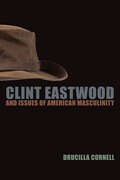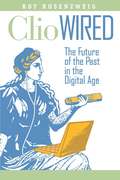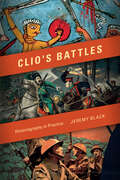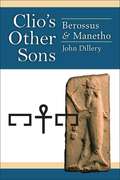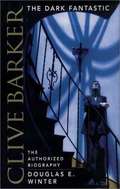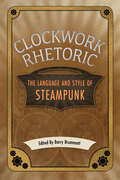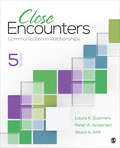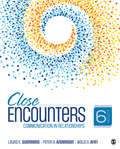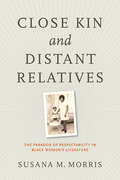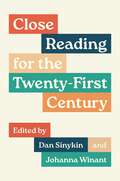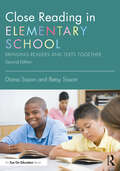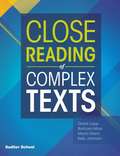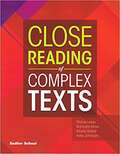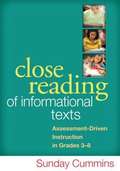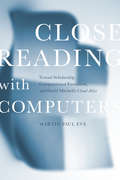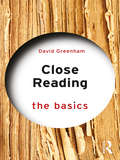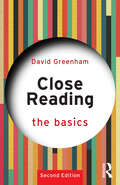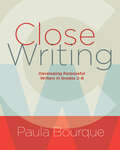- Table View
- List View
Clint Eastwood and Issues of American Masculinity
by Drucilla CornellIn this risk-taking book, a major feminist philosopher engages the work of the actor and director who has progressed from being the stereotypical “man’s man” to pushing the boundaries of the very genres—the Western, the police thriller, the war or boxing movie—most associated with American masculinity. Cornell’s highly appreciative encounter with the films directed by Clint Eastwood revolve around the questions “What is it to be a good man?” and “What is it to be, not just an ethical person, but specifically an ethical man?” Focusing on Eastwood as a director rather than as an actor or cultural icon, she studies Eastwood in relation to major philosophical and ethical themes that have been articulated in her own life’s work.In her fresh and revealing readings of the films, Cornell takes up pressing issues of masculinity as it is caught up in the very definition of ideas of revenge, violence, moral repair, and justice. Eastwood grapples with this involvement of masculinity in and through many of the great symbols of American life, including cowboys, boxing, police dramas, and ultimately war—perhaps the single greatest symbol of what it means (or is supposed to mean) to be a man. Cornell discusses films from across Eastwood’s career, from his directorial debut with Play Misty for Me to Million Dollar Baby.Cornell’s book is not a traditional book of film criticism or a cinematographic biography. Rather, it is a work of social commentary and ethical philosophy. In a world in which we seem to be losing our grip on shared symbols, along with community itself, Eastwood’s films work with the fragmented symbols that remain to us in order to engage masculinity with the most profound moral and ethical issues facing us today.
Clio Wired: The Future of the Past in the Digital Age
by Roy RosenzweigIn these visionary essays, Roy Rosenzweig charts the impact of new media on teaching, researching, preserving, presenting, and understanding history. Negotiating between the "cyberenthusiasts" who champion technological breakthroughs and the "digitalskeptics" who fear the end of traditional humanistic scholarship, Rosenzweig re-envisions academic historians' practices and professional rites while analyzing and advocating for amateur historians' achievements. While he addresses the perils of "doing history" online, Rosenzweig eloquently identifies the promises of digital work, detailing innovative strategies for powerful searches in primary and secondary sources, the increased opportunities for dialogue and debate, and, most of all, the unprecedented access afforded by the Internet. Rosenzweig draws attention to the opening up of the historical record to new voices, the availability of documents and narratives to new audiences, and the attractions of digital technologies for new and diverse practitioners. Though he celebrates digital history's democratizing influences, Rosenzweig also argues that we can only ensure the future of the past in this digital age by actively resisting the efforts of corporations to put up gates and profit from the Web.
Clio Wired: The Future of the Past in the Digital Age
by Roy RosenzweigIn these pathbreaking essays, Roy Rosenzweig charts the impact of new media on teaching, researching, preserving, presenting, and understanding history. Negotiating between the "cyberenthusiasts" who champion technological breakthroughs and the "digital skeptics" who fear the end of traditional humanistic scholarship, Rosenzweig re-envisions the practices and professional rites of academic historians while analyzing and advocating for the achievements of amateur historians. While he addresses the perils of "doing history" online, Rosenzweig eloquently identifies the promises of digital work, detailing innovative strategies for powerful searches in primary and secondary sources, the increased opportunities for dialogue and debate, and, most of all, the unprecedented access afforded by the Internet. Rosenzweig draws attention to the opening up of the historical record to new voices, the availability of documents and narratives to new audiences, and the attractions of digital technologies for new and diverse practitioners. Though he celebrates digital history's democratizing influences, Rosenzweig also argues that the future of the past in this digital age can only be ensured through the active resistance to efforts by corporations to control access and profit from the Web.
Clio's Battles: Historiography in Practice
by Jeremy BlackA survey of the variety of readings we have of the past and of how those readings are used in the present day to validate, discredit, unite, or divide.To write history is to consider how to explicate the past, to weigh the myriad possible approaches to the past, and to come to terms with how the past can be and has been used. In this book, prize-winning historian Jeremy Black considers both popular and academic approaches to the past. His focus is on the interaction between the presentation of the past and current circumstances, on how history is used to validate one view of the present or to discredit another, and on readings of the past that unite and those that divide. Black opens with an account that underscores the differences and developments in traditions of writing history from the ancient world to the present. Subsequent chapters take up more recent decades, notably the post–Cold War period, discussing how different perspectives can fuel discussions of the past by individuals interested in shaping public opinion or public perceptions of the past. Black then turns to the possible future uses of the then past as a way to gain perspective on how we use the past today. Clio’s Battles is an ambitious account of the engagement with the past across world history and of the clash over the content and interpretation of history and its implications for the present and future.“Remarkable both for its geographical scope and historical scale, and for its command of scholarship on a breathtaking range of subjects. I can’t imagine another historian who could attempt such an ambitious work or pull it off with such aplomb.” —William Gibson, Oxford Brookes University“Refreshing . . . Black eschews “Eurocentricism” and includes considerable material on other areas of the world that one does not usually find in such a work. Typical of Black’s writing, there is much to learn in the numerous small asides throughout the text. Taken together these form an impressive whole.” —Spencer C. Tucker, VMI
Clio's Other Sons: Berossus And Manetho
by John D. DillerySoon after the death of Alexander the Great, the priest Berossus wrote the first known narrative and comprehensive history of his native Babylon, and the priest Manetho likewise wrote the first such history of his native Egyptian civilization. Nothing like these histories had been produced before in these cultures. Clio's Other Sons considers why that is: why were these histories written at this point, and for what purposes? Berossus and Manetho operated at the crossings of several political, social, and intellectual worlds. They were members of native elites under the domination of Macedonian overlords; in their writings we can see suggestions that they collaborated in the foreign rule of their lands, but at the same time we see them advocating for their cultures. Their histories were written in Greek and betray active engagement with Greek historical writing, but at the same time these texts are clearly composed from native records, are organized along lines determined by local systems of time-reckoning, and articulate views that are deeply informed by regional scholarly and wisdom traditions. In this volume John Dillery charts the interactions of all these features of these historians. An afterword considers Demetrius, the approximate contemporary of Berossus and Manetho in time, if not in culture. While his associates wrote new histories, Demetrius' project was a rewriting of an existing text, the Bible. This historiographical "corrective" approach sheds light on the novel historiography of Manetho and Berossus.
Clitics: An Introduction
by Andrew Spencer Ana R. LuísIn most languages we find 'little words' which resemble a full word, but which cannot stand on their own. Instead they have to 'lean on' a neighbouring word, like the 'd, 've and unstressed 'em of Kim'd've helped'em ('Kim would have helped them'). These are clitics, and they are found in most of the world's languages. In English the clitic forms appear in the same place in the sentence that the full form of the word would appear in but in many languages clitics obey quite separate rules of placement. This book is the first introduction to clitics, providing a complete summary of their properties, their uses, the reasons why they are of interest to linguists and the various theoretical approaches that have been proposed for them. The book describes a whole host of clitic systems and presents data from over 100 languages.
Clive Barker: The Dark Fantastic
by Douglas E. Winter"Clive Barker: a modern mythmaker, explorer of our darkest instincts and ultimate fears, the writer who--more than any other contemporary figure--has shaped our nightmares through diverse media. Novelist, playwright, scriptwriter, artist and director, he is a master at twisting the mundane to make it fantastic, frightening and ultimately meaningful." "Douglas E. Winter's biography, made possible by unprecedented access to Barker and his closest friends and family, offers readers insight into Barker's own story: his Liverpool childhood and adolescence; his forays into the world of theatre, mime and direction; his rise to fame as the author of the Books of Blood and Weaveworld, and the director of Hellraiser; his move to Hollywood to pursue a film career and his growth as an artist in many different media, which has taken him from theatre--the first form of human expression--into the digital age."--BOOK JACKET.
Clockwork Rhetoric: The Language and Style of Steampunk
by Barry BrummettThis unique book explores how the aesthetic and cultural movement “Steampunk” persuades audiences and wins new acolytes. Steampunk is an aesthetic style grounded in the Victorian era, in clothing and accoutrements modeled on a heightened and hyper-extended age of steam. In addition to its modeling of attire and other symbolic trappings, what is most distinctive is its adherents' use of a machined aesthetic based on steam engines and early electrical machinery—gears, pistons, shafts, wheels, induction motors, clockwork and so forth. Precursors to steampunk can be found in the works of Jules Verne and H. G. Wells. The imagery of the American West contributed to the aesthetic—revolvers, locomotives, and rifles of the late nineteenth century. Among young people, steampunk has found common aesthetic cause with Goth style. Examples from literature and popular culture include William Gibson's fiction, China Miéville's novels, the classic film Metropolis, and the BBC series Doctor Who. This volume recognizes that steampunk, a unique popular culture phenomenon, presents a prime opportunity for rhetorical criticism. Steampunk's art, style, and narratives convey complex social and political meanings. Chapters in Clockwork Rhetoric explore topics ranging from jewelry to Japanese anime to contemporary imperialism to fashion. Throughout, the book demonstrates how language influences consumers of steampunk to hold certain social and political attitudes and commitments.
Close Encounters: Communicating in Relationships
by Walid A. Afifi Peter A. Andersen Laura K. GuerreroClose Encounters provides more in-depth coverage of theory than is typical in most interpersonal communication textbooks.
Close Encounters: Communication in Relationships
by Dr Laura K. Guerrero Dr Peter A. Andersen Dr Walid AfifiA relational approach to the study of interpersonal communication Close Encounters: Communication in Relationships, Fifth Edition helps students better understand their relationships with romantic partners, friends, and family members. Bestselling authors Laura K. Guerrero, Peter A. Andersen, and Walid A. Afifi offer research-based insights and content illustrated with engaging scenarios to show how state-of-the-art research and theory can be applied to specific issues within relationships—with a focus on issues that are central to describing and understanding close relationships. While maintaining the spotlight on communication, the authors also emphasize the interdisciplinary nature of the study of personal relationships by including research from such disciplines as social psychology and family studies. The book covers issues relevant to developing, maintaining, repairing, and ending relationships. Both the "bright" and "dark" sides of interpersonal communication within relationships are explored.
Close Encounters: Communication in Relationships
by Dr Laura K. Guerrero Dr Peter A. Andersen Dr Walid AfifiA relational approach to the study of interpersonal communication Close Encounters: Communication in Relationships, Fifth Edition helps students better understand their relationships with romantic partners, friends, and family members. Bestselling authors Laura K. Guerrero, Peter A. Andersen, and Walid A. Afifi offer research-based insights and content illustrated with engaging scenarios to show how state-of-the-art research and theory can be applied to specific issues within relationships—with a focus on issues that are central to describing and understanding close relationships. While maintaining the spotlight on communication, the authors also emphasize the interdisciplinary nature of the study of personal relationships by including research from such disciplines as social psychology and family studies. The book covers issues relevant to developing, maintaining, repairing, and ending relationships. Both the "bright" and "dark" sides of interpersonal communication within relationships are explored.
Close Encounters: Communication in Relationships
by Peter A. Andersen Laura K. Guerrero Walid AfifiClose Encounters: Communication in Relationships helps students learn about their own relationships with romantic partners, friends, and family members by focusing on issues that are central to describing and understanding close relationships. Best-selling authors Laura K. Guerrero, Peter A. Andersen, and Walid A. Afifi present research-based insights and content illustrated with engaging scenarios to show how state-of-the-art research and theory can be applied to specific issues within relationships. The updated Sixth Edition includes fresh content reflecting current research and trends in relationships, balanced with coverage of classic research, and continues to empower readers to be more critical consumers of information about relationships.
Close Encounters: Communication in Relationships
by Peter A. Andersen Laura K. Guerrero Walid AfifiClose Encounters: Communication in Relationships helps students learn about their own relationships with romantic partners, friends, and family members by focusing on issues that are central to describing and understanding close relationships. Best-selling authors Laura K. Guerrero, Peter A. Andersen, and Walid A. Afifi present research-based insights and content illustrated with engaging scenarios to show how state-of-the-art research and theory can be applied to specific issues within relationships. The updated Sixth Edition includes fresh content reflecting current research and trends in relationships, balanced with coverage of classic research, and continues to empower readers to be more critical consumers of information about relationships.
Close Kin and Distant Relatives: The Paradox of Respectability in Black Women's Literature
by Susana M. MorrisThe "black family" in the United States and the Caribbean often holds contradictory and competing meanings in public discourse: on the one hand, it is a site of love, strength, and support; on the other hand, it is a site of pathology, brokenness, and dysfunction that has frequently called forth an emphasis on conventional respectability if stability and social approval are to be achieved. Looking at the ways in which contemporary African American and black Caribbean women writers conceptualize the black family, Susana Morris finds a discernible tradition that challenges the politics of respectability by arguing that it obfuscates the problematic nature of conventional understandings of family and has damaging effects as a survival strategy for blacks. The author draws on African American studies, black feminist theory, cultural studies, and women’s studies to examine the work of Paule Marshall, Jamaica Kincaid, Edwidge Danticat, and Sapphire, showing how their novels engage the connection between respectability and ambivalence. These writers advocate instead for a transgressive understanding of affinity and propose an ethic of community support and accountability that calls for mutual affection, affirmation, loyalty, and respect. At the core of these transgressive family systems, Morris reveals, is a connection to African diasporic cultural rites such as dance, storytelling, and music that help the fictional characters to establish familial connections.
Close Reading for the Twenty-First Century (Skills for Scholars)
by Dan Sinykin Johanna WinantA user&’s guide to the fundamental practice of literary studies, providing context, examples, and practical exercises Close reading—making an argument based in close attention to a text—is the foundation of literary studies. This book offers a guide to close reading, treating it as a skill that can be taught and practiced. It first explains what close reading is, what it does, and how it has been used across theoretical schools ranging from affect studies to Black studies to queer theory to Marxism. It then presents a series of master classes in the practice, with original contributions by scholars from a range of different institutions. Finally, it provides practical materials, worksheets, and suggested activities for instructors to use in the classroom. The tone throughout is encouraging and accessible, inviting readers of all backgrounds to hone their craft.The book divides the practice of close reading into five steps, coining a term for each step: scene setting, noticing, local claiming, regional argumentation, and global theorizing. It traces the roots of close reading, showing how it has spread far beyond its origins in practical criticism and New Criticism. In twenty-one short chapters, contemporary scholars discuss close readings by such prominent literary critics as Erich Auerbach and Helen Vendler, describing how their arguments work and how to achieve similar results. An essential resource for instructors and students at the undergraduate level and beyond, this book shows how understanding close reading can make us better readers, thinkers, and writers.
Close Reading in Elementary School: Bringing Readers and Texts Together
by Diana Sisson Betsy SissonMany literacy experts believe close reading has the power to create strong, independent readers, but what does that really mean, and how does it work in the classroom? This book is your must-have guide to getting started! It provides step-by-step strategies and scaffolds for teaching close reading and improving students’ comprehension of complex texts. You will learn how to teach close reading based on text type, how to accelerate learning through increasingly challenging texts in both print and digital media, how to use close reading as a springboard for close talks and close writes, and how to support your students to move forward confidently with a repertoire of tools to employ as they navigate complex text in their daily lives.Special Features: A clear explanation of what text complexity really means and how it varies by student An easy-to-use framework for creating a close reading lesson that builds student reading stamina Scaffolds to help students at all ability levels to do a close reading Close reading strategies for a variety of literary and informational genres Ideas for strengthening reading through targeting comprehension skills, including analyzing text structure and evaluating arguments Suggestions for helping students read with increasing levels of rigor Techniques for how to lessen student technology distractions and dig deeper into digital text Guidelines and procedures for close talks – purposeful, focused discussions about text Procedures for close writes that vary based on genre and student ability level Recommendations to ensure students have the close reading skills to be effective readers in and out of the classroom In addition, each chapter includes study guide questions to help you apply the ideas in the book to your own classroom. With this practical book, you will have all the tools you need to make close reading a reality!
Close Reading of Complex Texts
by Diane Lapp Barbara Moss Maria GrantClose Reading of Complex Texts, Grade 5, is a consumable Student Worktext with texts sets and formative assessments included.
Close Reading of Complex Texts
by Diane Lapp Kelly Johnson Barbara Moss Maria GrantThis book provides the text sets and text-dependent questions you need to support instruction in the close reading and critical analysis of complex texts. You’ll find: Expertly curated text sets for a variety of disciplines to save you time in your preparation; Meaningful Focus Questions to connect texts and build students’ knowledge on each topic; Carefully crafted, Text-Dependent Questions to help students closely and critically read increasingly complex texts.
Close Reading of Complex Texts, Grade 7
by Diane Lapp Kelly Johnson Barbara Moss Maria GrantClose reading is reading a text more than once in order to understand its deeper meaning. You uncover the reasons authors choose particular words and phrases, include literary elements and plot points, or organize the text or introduce information a particular way. You draw connections between the ideas and details in the texts--and from specific texts to bigger topics. You will read the texts in Close Reading of Complex Texts three times, with a different purpose each time. 1st READ - Determine what the text is about. 2nd READ - Focus on the language used by the author and the structure of the text. 3rd READ - Look for meaning by making inferences.
Close Reading of Informational Texts
by Sunday CumminsThis essential book provides a roadmap for instruction and assessment of close reading skills in grades 3-8. To engage deeply with informational texts--a key requirement of the Common Core standards--students need to determine what details are important, how they fit together to convey a central idea, and how to synthesize information from multiple sources. They also need to understand the unique demands of different text features and structures. Presenting effective instructional strategies that teachers can tailor to their own classrooms, the book includes lesson plans, vignettes, and examples of student work, plus a Study Guide with professional learning activities and discussion questions.
Close Reading the Anthropocene
by Helena FederReading poetry and prose, images and art, literary and critical theory, science and cultural studies, Close Reading the Anthropocene explores the question of meaning, its importance and immanent potential for loss, in the new geological epoch of the Anthropocene. Both close reading and scientific ecology prioritize slowing down and looking around to apprehend similarities and differences, to recognize and value interconnections. Here "close" suggests careful attention to both the reading subject and read "object." Moving between places, rocks, plants, animals, atmosphere, and eclipses, this interdisciplinary edited collection grounds the complex relations between text and world in the environmental humanities. The volume’s wide-ranging chapters are critical, often polemical, engagements with the question of the Anthropocene and the changing conversation around reading, interpretation, and textuality. They exemplify a range of work from across the globe and will be of great interest to scholars and students of the environmental humanities, ecocriticism, and literary studies.
Close Reading with Computers: Textual Scholarship, Computational Formalism, and David Mitchell's <i>Cloud Atlas</i>
by Martin Paul EveMost contemporary digital studies are interested in distant-reading paradigms for large-scale literary history. This book asks what happens when such telescopic techniques function as a microscope instead. The first monograph to bring a range of computational methods to bear on a single novel in a sustained fashion, it focuses on the award-winning and genre-bending Cloud Atlas (2004). Published in two very different versions worldwide without anyone taking much notice, David Mitchell's novel is ideal fodder for a textual-genetic publishing history, reflections on micro-tectonic shifts in language by authors who move between genres, and explorations of how we imagine people wrote in bygone eras. Though Close Reading with Computers focuses on but one novel, it has a crucial exemplary function: author Martin Paul Eve demonstrates a set of methods and provides open-source software tools that others can use in their own literary-critical practices. In this way, the project serves as a bridge between users of digital methods and those engaged in more traditional literary-critical endeavors.
Close Reading: The Basics (The Basics)
by David GreenhamClose reading is the most essential skill that literature students continue to develop across the full length of their studies. This book is the ideal guide to the practice, providing a methodology that can be used for poetry, novels, drama, and beyond. Using classic works of literature, such as Hamlet and The Great Gatsby as case studies, David Greenham presents a unique, contextual approach to close reading, while addressing key questions such as: What is close reading? What is the importance of the relationships between words? How can close reading enhance reading pleasure? Is there a method of close reading that works for all literary genres? How can close reading unlock complexity? How does the practice of close reading relate to other theoretical and critical approaches? Close Reading: The Basics is formulated to bring together reading pleasure and analytic techniques that will engage the student of literature and enhance their reading experience.
Close Reading: The Basics (The Basics)
by David GreenhamClose reading is an essential skill that literature students continue to develop across the full length of their studies. This book, now in its second edition, is a complete guide to this foundational practice, providing an effective first principles methodology that can be used for poetry, novels, drama, and beyond.Offering model close readings of classic works of literature, including Hamlet, The Great Gatsby and Beloved, David Greenham presents a unique, contextual approach to close reading, while addressing key questions such as: What is close reading? What is the importance of the relationships between words? How can close reading enhance reading pleasure? Is there a method of close reading that works for all literary genres? How can close reading unlock complexity? How does the practice of close reading relate to contemporary theoretical, critical and political concerns? The second edition of Close Reading: The Basics is carefully formulated to bring together reading pleasure and analytic techniques that will engage the student of literature and enhance their reading experience.
Close Writing: Developing Purposeful Writers in Grades 2-6
by Paula BourqueHow closely do your students read their writing? What are the implications for those who do and those who don't? During her work in classrooms, literacy coach Paula Bourque noticed that students who read their own writing closely are engaged in their work, write fluently, are able to produce lengthy drafts, and incorporate teaching points from mini-lessons into the day's writing. In this comprehensive book, Paula shows you that no matter what structures or lessons you use in your writing classroom, the strategies in Close Writing will help you make these better by creating student writers who are more aware of what effective writing looks like, who care about what they write, and who take ownership and responsibility for their growth as writers. Paula argues that a key element in close writing is learning to look and looking to learn by closely reading our own writing. Instead of focusing on the mechanics of their writing, she encourages students to read their words for understanding, clarity, and the effect they will have on an audience. She urges them to recognize their habits and their approaches to writing and to build upon them.Close Writing is based on research and methods that are reliable and valid best practices, but it will not prescribe lessons or structures. It gives you a peek inside classrooms where teachers just like you are working with budding authors just like yours. Paula also provides considerations for ELL writers, as well as a section of interviews with authors. She shares an extensive reference/resource guide, and a companion website with students' work samples, reproducibles and templates, and videos of classroom writing lessons round out this must-have resource.
